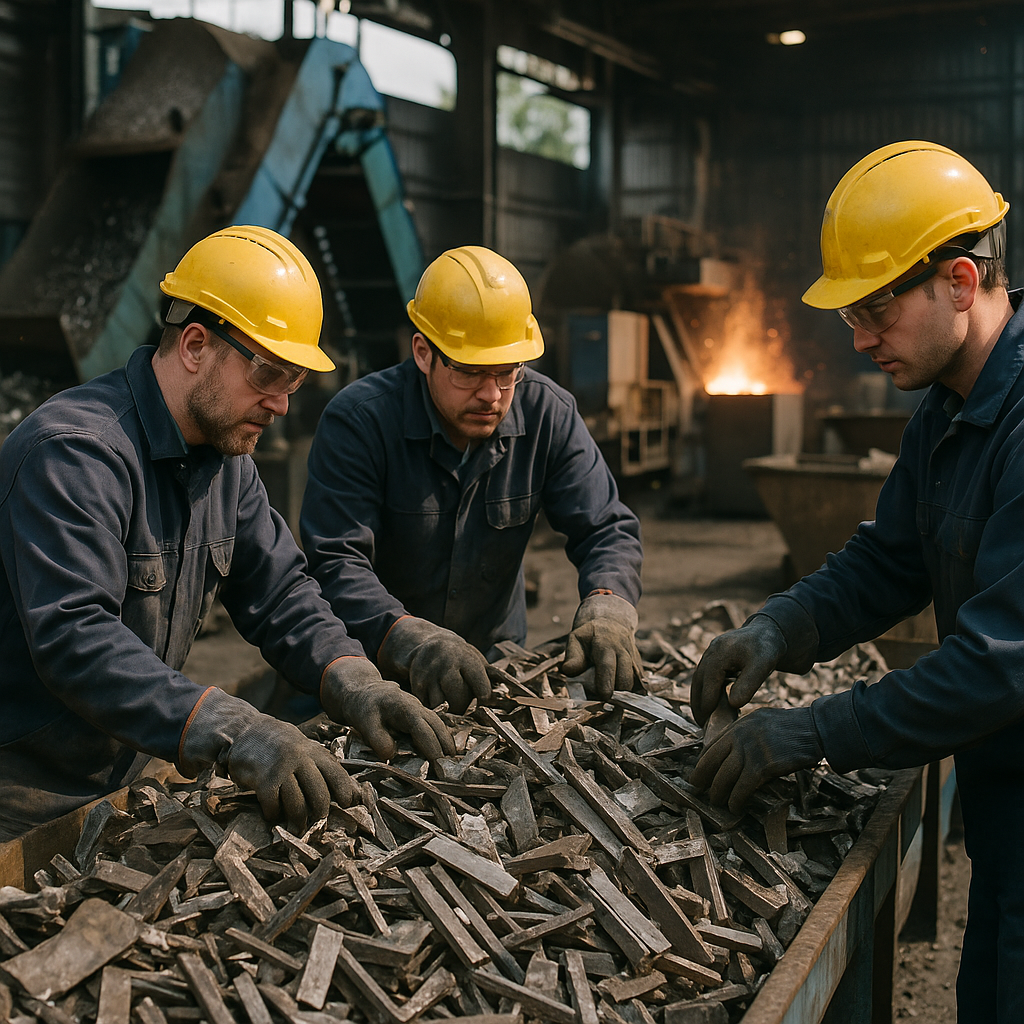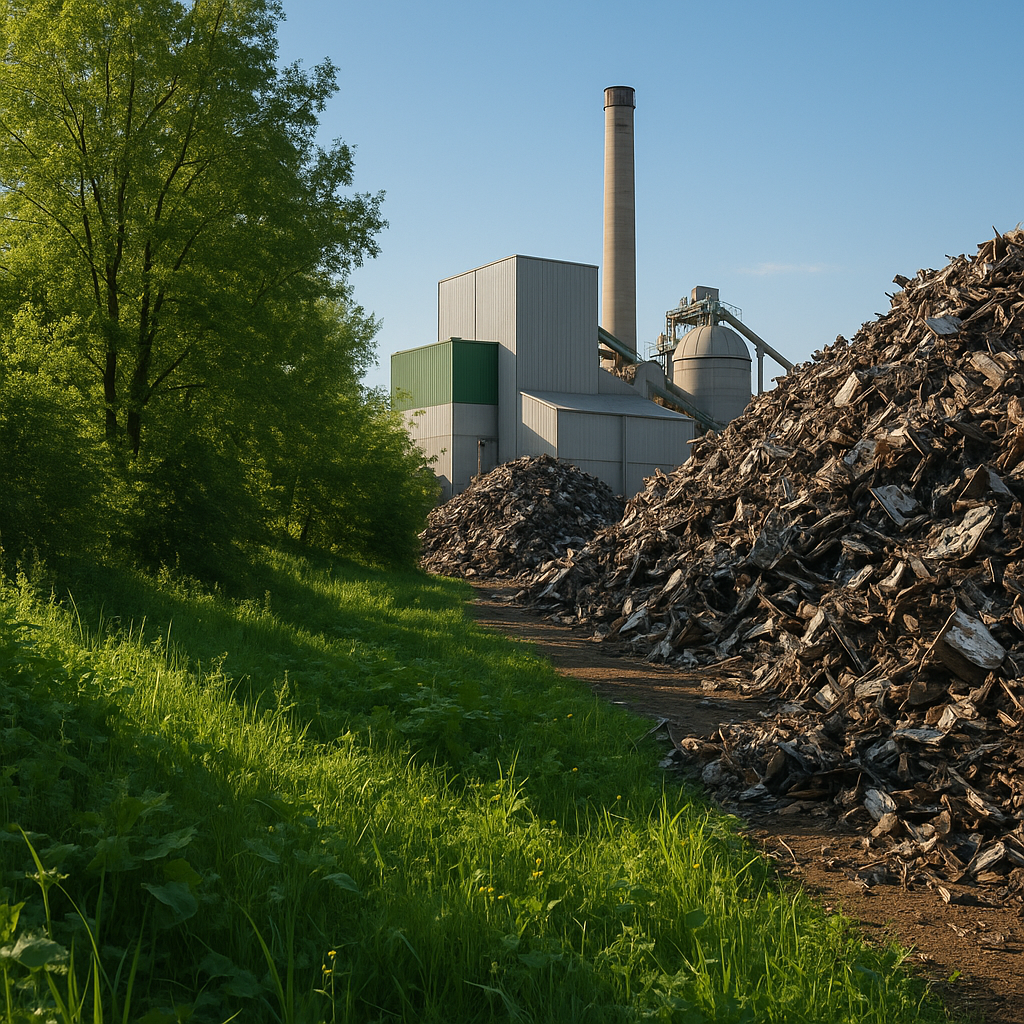5901 Botham Jean Blvd, Dallas, TX 75215
Ferrous Steel Scrap: Recycling Process, Benefits, and Economic Impact
September 28, 2025Ferrous steel scrap includes all recyclable materials containing iron. This valuable resource consists of discarded steel and iron products that have reached the end of their useful life. A simple test reveals its identity—ferrous scrap is magnetic, making it easy to distinguish from other recyclable metals.
Sources of ferrous scrap are prevalent in everyday life. It comes from retired vehicles with their steel frames and components. Old appliances like refrigerators and washing machines contribute significantly to the ferrous scrap stream. Construction and demolition projects yield substantial amounts from structural beams, rebar, and metal fixtures.
As a critical input for the steel industry, ferrous scrap plays an important role in modern manufacturing. Steel mills rely on this material to produce new steel products with a lower environmental impact than using virgin materials. By integrating ferrous scrap into production processes, manufacturers support the circular economy model, where materials maintain their value through multiple lifecycles rather than being discarded after a single use.
How is Ferrous Steel Scrap Recycled?

The recycling process for ferrous steel scrap follows a systematic approach, transforming discarded metal into valuable new products. This process conserves natural resources and reduces energy consumption by 75% compared to producing steel from raw materials. Here’s a detailed look at each step.
1. Collection and Sorting
The journey starts with collection from various sources, including automobiles, construction sites, and household appliances. Once gathered, ferrous metal is separated from other materials using powerful magnets. This magnetic separation is effective because ferrous metals contain iron, making them strongly attracted to magnets.
Advanced sorting technologies, including sensors and automated systems, further classify the scrap by steel type and composition. Precise sorting is crucial because different steel grades require specific processing methods.
2. Grading and Quality Assessment
Steel scrap is carefully graded by quality, composition, and potential applications. Scrap dealers and recycling facilities classify materials according to industry standards. Higher grades contain fewer impurities and are used for premium steel products.
Quality assessment involves examining the steel for contaminants like rubber, plastic, or other metals that could compromise the recycling process. Skilled workers perform visual inspections alongside automated systems to ensure proper classification.
3. Shredding and Size Reduction
After sorting, steel scrap is processed through industrial shredders that break down larger pieces into smaller, more manageable fragments. These powerful machines can process entire automobiles in minutes. The shredding process reduces the physical volume of the scrap and creates pieces with increased surface area.
Smaller fragments with greater surface area melt more efficiently, reducing energy requirements in subsequent stages. The shredded material is often compressed into dense blocks or bales for easier handling and transportation.
4. Melting in Electric Arc Furnaces
The core transformation occurs when processed scrap enters electric arc furnaces (EAFs) at steel mills. These specialized furnaces use high-voltage electric arcs that generate intense heat between carbon electrodes. Temperatures reach approximately 3,000°F (1,650°C), turning solid steel into molten metal.
EAFs are well-suited for recycling because they can process 100% scrap metal input. The furnaces efficiently melt the ferrous scrap while burning off remaining impurities. This process typically takes between 20-60 minutes, depending on furnace capacity and scrap quality.
5. Purification and Refining
Once melted, the liquid steel undergoes purification to remove any remaining contaminants. Mill operators analyze the chemical composition and add alloying elements to achieve desired properties for specific applications. These elements might include carbon, manganese, or chromium, depending on the intended use of the final product.
The molten steel is then cast into semi-finished forms like billets, blooms, or slabs. These intermediate products serve as the starting point for manufacturing various steel products.
6. Manufacturing Into New Products
In the final stage, the recycled steel is formed into finished products through rolling, extrusion, or other fabrication processes. The versatility of recycled steel allows it to be transformed into countless products, including:
- Construction materials (rebar, beams, plates)
- Automotive components
- Appliances and containers
- Infrastructure elements like bridges and railways
- Sheet metal for various applications
The quality of properly recycled steel matches or even exceeds that of steel made from virgin materials. A single ton of recycled steel saves approximately 2,500 pounds of iron ore, 1,400 pounds of coal, and 120 pounds of limestone from being mined.
Environmental and Economic Impact
This efficient recycling process reduces CO2 emissions by 58% compared to producing steel from raw materials. Steel can be recycled repeatedly without degradation in quality, making it one of the most sustainable materials in manufacturing.
The steel recycling industry creates significant economic benefits, generating billions in revenue while providing thousands of jobs across the collection, processing, and manufacturing sectors.
What Are the Environmental Benefits of Recycling Ferrous Steel Scrap?

Recycling ferrous steel scrap offers substantial environmental benefits, extending far beyond waste reduction. It represents one of the most effective strategies for industries aiming to positively impact the ecosystem.
Reduction in Greenhouse Gas Emissions
One key environmental advantage of recycling ferrous steel scrap is the significant reduction in greenhouse gas emissions. Producing steel with Electric Arc Furnace (EAF) technology using recycled scrap results in less than a third of the greenhouse gas emissions compared to traditional blast furnace methods. This reflects a 58 percent emissions reduction when using ferrous scrap instead of virgin materials.
The Environmental Protection Agency indicates that recycling one ton of steel prevents about 1,000 to 1,500 pounds of carbon dioxide from entering the atmosphere. When scaled across the millions of tons recycled annually, the climate impact is immense—comparable to removing millions of cars from roads.
This reduction plays a crucial role in tackling climate change, helping industries meet stringent carbon reduction targets. For manufacturers and construction companies committed to sustainability, using recycled ferrous scrap provides a clear path to lowering their carbon footprint.
Conservation of Natural Resources
Recycling ferrous steel significantly conserves natural resources. Each ton of recycled steel saves approximately 2,500 pounds of iron ore, 1,400 pounds of coal, and 120 pounds of limestone, which would otherwise require disruptive mining operations.
Conservation benefits also extend to water resources. Recycling uses 40 percent less water compared to primary steel production, a vital consideration as many regions face growing water scarcity issues.
By decreasing the need for new mining operations, recycling ferrous steel scrap helps preserve natural habitats, prevent soil erosion, and maintain biodiversity in areas otherwise disrupted by resource extraction activities.
Landfill Waste Reduction
Steel takes hundreds of years to degrade naturally. Recycling ferrous scrap significantly reduces the volume of waste in landfills, which is increasingly valuable as suitable sites become scarce and costly to develop.
Beyond conserving space, recycling prevents potential contamination issues associated with metals. Some metals can leach compounds into soil and groundwater over time. Recycling eliminates this environmental risk and transforms potential waste into valuable manufacturing inputs.
The Northeast Recycling Council notes that recycled steel production reduces water pollution by 76 percent compared to primary production methods, benefiting aquatic ecosystems and nearby drinking water sources.
Supporting a Circular Economy
A forward-thinking benefit of ferrous steel recycling is its role in promoting a circular economy. Unlike the traditional linear “take-make-dispose” model, recycling forms a continuous loop where materials remain in productive use indefinitely. Steel is ideally suited for this approach as it can be recycled repeatedly without losing its strength or quality.
This circularity fundamentally changes how we view resources. What was once waste becomes valuable feedstock for new production. Many modern mills are designed to use recycled content as their primary input, demonstrating the steel industry’s reliance on this material flow.
The circular approach fosters economic stability while reducing environmental impact. It creates jobs in collection, processing, and manufacturing while decreasing dependence on volatile raw material markets and international supply chains.
| Energy Reduction | Recycled steel production uses 75% less energy than virgin steel production. |
| Emissions Reduction | Recycling reduces CO2 emissions by 58%, equivalent to removing millions of cars from roadways annually. |
| Water Conservation | Recycling uses 40% less water compared to primary production methods. |
| Natural Resource Conservation | Recycling one ton of steel saves 2,500 pounds of iron ore, 1,400 pounds of coal, and 120 pounds of limestone. |
| Air Pollution Reduction | Using recycled steel cuts air pollution by 86% compared to primary production methods. |
| Water Pollution Reduction | Recycling results in a 76% reduction in water pollution. |
| Landfill Waste Reduction | Recycling steel diverts substantial amounts of waste from landfills, conserving space. |
By supporting ferrous steel recycling, industries not only reduce their environmental impact but also contribute to a more sustainable and resilient economy that provides materials indefinitely without depleting natural resources.
What Are the Economic Impacts of Ferrous Steel Scrap Recycling?

Ferrous steel scrap recycling generates substantial economic benefits both locally and nationally. The industry creates thousands of jobs across the recycling chain, employing collection workers, processing plant operators, equipment technicians, and logistics personnel. According to industry research, the recycling sector supports over 500,000 jobs in the United States, with ferrous steel recycling comprising a significant portion of this workforce.
For businesses and individuals, selling scrap metal provides a valuable income stream. Companies can convert industrial byproducts and end-of-life equipment into revenue instead of incurring disposal costs. Individuals earn supplemental income by collecting and selling scrap from various sources. After natural disasters like hurricanes or floods, scrap recovery often provides communities with immediate financial relief and supports cleanup efforts.
The economic ripple effect extends beyond recycling facilities. The industry generates billions in tax revenue annually, contributing approximately $5 billion to local governments and $6.8 billion in federal taxes. These funds support essential community services and infrastructure development.
Ferrous steel recycling strengthens supply chain resilience by using domestically available scrap, reducing reliance on imported raw materials. This local sourcing helps shield the industry from international market volatility and supply disruptions. Manufacturers benefit from more stable material costs, creating a predictable business environment.
The industry also delivers substantial cost savings throughout the production chain. Manufacturing with recycled steel requires significantly less energy than processing virgin materials. The U.S. Geological Survey reports that recycling a ton of steel conserves 1.1 tons of iron ore and other minerals. These efficiency gains lead to more competitive pricing for steel-dependent industries like construction, automotive manufacturing, and infrastructure development.
Ferrous scrap recycling contributes approximately $23 billion annually in domestic sales and exports. This economic activity represents about 0.68% of the nation’s total economic output, comparable to the data processing and automotive repair industries. The sector’s export activity alone generates over $28 billion in economic benefits, creating roughly 125,000 jobs.
The industry plays a crucial role in supporting domestic steel production. Recycled ferrous materials provide reliable inputs for steel mills nationwide, promoting manufacturing self-sufficiency and reducing economic vulnerability to international trade fluctuations.
At its core, ferrous steel recycling transforms potential waste into valuable economic resources. This circular economic model creates jobs, generates tax revenue, stabilizes supply chains, and supports manufacturing competitiveness. These combined economic impacts make ferrous steel recycling not just environmentally sound but economically essential.
How Can Individuals and Businesses Participate in Ferrous Steel Scrap Recycling?

Individuals and businesses can easily join the ferrous steel recycling movement. The process is straightforward and offers both environmental sustainability and potential financial returns. With just a valid driver’s license, anyone can start contributing to this important resource conservation effort.
Identifying Recyclable Ferrous Metals
Ferrous metals include those containing iron, such as steel, cast iron, and wrought iron. These materials are commonly found in everyday items and industrial settings. Before recycling, it helps to identify what qualifies as ferrous scrap.
Common sources of recyclable ferrous metals include:
- Old household appliances (refrigerators, washing machines, stoves)
- Automotive parts and end-of-life vehicles
- Construction materials (steel beams, rebar)
- Industrial cut-offs and manufacturing waste
- Plumbing fixtures and pipes
A simple way to determine if metal is ferrous is to check if a magnet sticks to it. Ferrous metals are magnetic, making them easy to identify and separate from non-ferrous metals like aluminum or copper.
Finding Local Recycling Centers
Many recycling facilities across the country accept ferrous metal scrap. Nucor, one of America’s largest steel producers, operates over 70 scrap recycling facilities nationwide through its subsidiaries. These include Advantage Metals Recycling, Metal Recycling Services, River Metals Recycling, and more, strategically located throughout the United States.
Local scrap yards, municipal recycling centers, and specialized metal recyclers also accept ferrous materials. Many offer pickup services for larger quantities, particularly for businesses with substantial amounts of scrap metal.
When choosing a recycling center, consider factors such as:
- Proximity to your location
- Current buying rates for ferrous metals
- Minimum quantity requirements
- Available transportation assistance
The Selling Process
Selling ferrous scrap metal is simple. The process typically involves:
1. Collecting and sorting your ferrous metals
2. Transporting the materials to a recycling center
3. Having your scrap weighed and evaluated
4. Receiving payment based on current market rates
Most recycling facilities require only a valid driver’s license to complete the transaction, making it accessible to nearly everyone. Businesses may need to provide additional documentation for tax purposes or when selling large quantities.
Financial Benefits
While ferrous metals typically fetch lower prices per pound than non-ferrous metals like copper or aluminum, the ability to collect and sell them in larger volumes often results in substantial payments. Prices fluctuate based on market conditions, including global steel demand and production costs.
For businesses, ferrous metal recycling offers several financial advantages:
- Revenue generation from materials that would otherwise be discarded
- Reduced waste disposal costs
- Potential tax benefits through sustainable business practices
- Enhanced reputation through environmental stewardship
Individuals can supplement their income through regular collection and selling of scrap metal, with some dedicated scrappers turning this activity into a significant revenue stream.
Environmental Impact
Beyond financial benefits, participating in ferrous steel recycling makes a substantial environmental impact. Recycling one ton of steel conserves approximately 2,500 pounds of iron ore, 1,400 pounds of coal, and 120 pounds of limestone that would otherwise be mined to produce new steel.
The energy savings are equally impressive, with recycled steel production using significantly less energy than creating steel from raw materials. This results in reduced greenhouse gas emissions and a smaller carbon footprint.
By recycling ferrous metals, participants actively contribute to:
- Conservation of natural resources
- Reduction of mining impacts
- Lower energy consumption in steel production
- Decreased landfill usage
- Support for a circular economy
The circular nature of steel recycling means materials can be recycled repeatedly without losing their essential properties, creating a sustainable loop that benefits both the economy and environment.
Conclusion
Ferrous steel scrap recycling is a highly effective way to conserve resources, reduce emissions, and promote a truly circular economy. From minimizing landfill waste to strengthening domestic supply chains, its benefits span environmental, economic, and community aspects. Whether you’re a homeowner with old appliances or a business managing industrial offcuts, recycling ferrous metals transforms discarded material into valuable products while helping protect the planet for future generations.
For your metal recycling needs, contact Okon Recycling at 214-717-4083. Turn your ferrous scrap into savings and sustainability with a trusted recycling partner.
